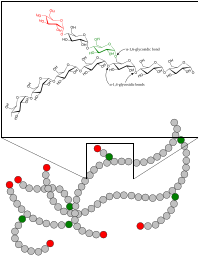
Back Pfropfcopolymerisation German Polymère ramifié French Catena ramificata Italian 分枝 (化学) Japanese Entcopolymeer Dutch Polímero ramificado Portuguese
This article needs additional citations for verification. (August 2013) |
branched chain: A chain with at least one branch point intermediate between the boundary units. [1]
branch (side chain, pendant chain): An oligomer molecule or polymeric offshoot from a macromolecular chain. (See Gold Book entry for note.) [2]


In polymer chemistry, branching is the regular or irregular attachment of side chains to a polymer's backbone chain. It occurs by the replacement of a substituent (e.g. a hydrogen atom) on a monomer subunit by another covalently-bonded chain of that polymer; or, in the case of a graft copolymer, by a chain of another type. Branched polymers have more compact and symmetrical molecular conformations, and exhibit intra-heterogeneous dynamical behavior with respect to the unbranched polymers.[3][4] In crosslinking rubber by vulcanization, short sulfur branches link polyisoprene chains (or a synthetic variant) into a multiple-branched thermosetting elastomer. Rubber can also be so completely vulcanized that it becomes a rigid solid, so hard it can be used as the bit in a smoking pipe. Polycarbonate chains can be crosslinked to form the hardest, most impact-resistant thermosetting plastic, used in safety glasses.[5]
Branching may result from the formation of carbon-carbon or various other types of covalent bonds. Branching by ester and amide bonds is typically by a condensation reaction, producing one molecule of water (or HCl) for each bond formed.
Polymers which are branched but not crosslinked are generally thermoplastic. Branching sometimes occurs spontaneously during synthesis of polymers; e.g., by free-radical polymerization of ethylene to form polyethylene. In fact, preventing branching to produce linear polyethylene requires special methods. Because of the way polyamides are formed, nylon would seem to be limited to unbranched, straight chains. But "star" branched nylon can be produced by the condensation of dicarboxylic acids with polyamines having three or more amino groups. Branching also occurs naturally during enzymatically-catalyzed polymerization of glucose to form polysaccharides such as glycogen (animals), and amylopectin, a form of starch (plants). The unbranched form of starch is called amylose.
The ultimate in branching is a completely crosslinked network such as found in Bakelite, a phenol-formaldehyde thermoset resin.
- ^ "branched chain". Gold Book. IUPAC. doi:10.1351/goldbook.B00721. Retrieved 1 April 2024.
- ^ "branch (side chain, pendant chain)". Gold Book. IUPAC. doi:10.1351/goldbook.B00720. Retrieved 1 April 2024.
- ^ Alexandros Chremos; Jack F. Douglas (2015). "When does a branched polymer become a particle?". J. Chem. Phys. 143 (11): 111104. Bibcode:2015JChPh.143k1104C. doi:10.1063/1.4931483. PMID 26395679.
- ^ Alexandros Chremos; E. Glynos; P. F. Green (2015). "Structure and dynamical intra-molecular heterogeneity of star polymer melts above glass transition temperature". Journal of Chemical Physics. 142 (4): 044901. Bibcode:2015JChPh.142d4901C. doi:10.1063/1.4906085. PMID 25638003.
- ^ "Polycarbonate". Pslc.ws. Retrieved October 22, 2012.